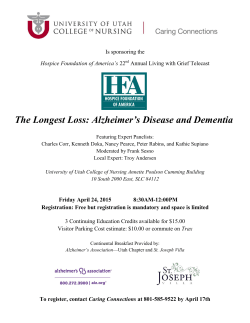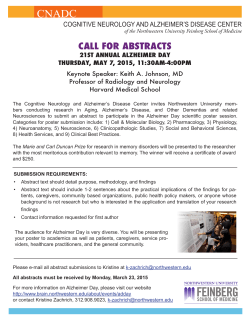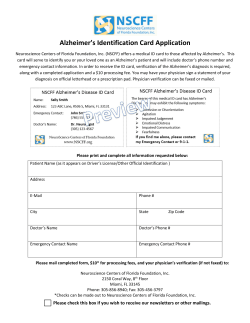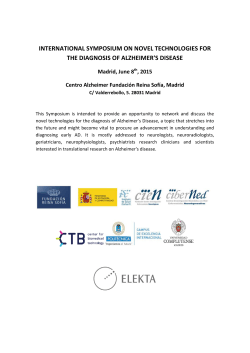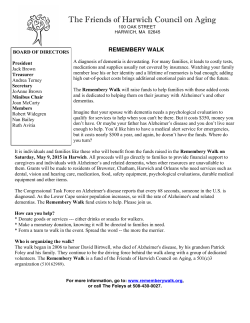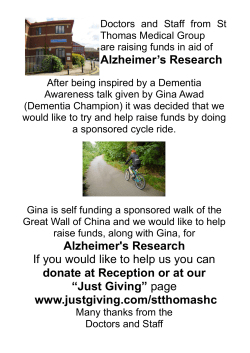
ALZHEIMER`S DISEASE:
ALZHEIMER’S DISEASE: THE LATEST SCIENTIFIC RESEARCH & INNOVATION Alzheimer’s disease is a condition without a cure; it affects 35 million people worldwide and care costs in the United States alone are on course to reach $1.1 trillion by 2050. To date, no drug has reached the market that is able to slow its progress – currently approved agents treat only its symptoms. Despite the desperate need for a breakthrough, the area has been somewhat marginalized with funding in very short supply. Expectations have been further dampened by the recent failures of several late-stage and previously promising agents. However, a number of recent advances have cast a more hopeful light on this potentially lucrative field. The U.S. Government has pledged $130 million for R&D into the disease, with a further $26 million for ancillary issues such as care-giver support. New diagnostic agents are entering the market that will help identify and treat patients, and a number of studies investigating the very early stages of the disease have been launched. “ We really owe it to ourselves and future generations to create a world without Alzheimer’s, and I think we can. Twenty years ago I wouldn’t have said that—we didn’t know enough. And now it’s changed so dramatically that I say a cure will come as quickly as the people want it to come, in terms of being willing to commit the necessary resources.” John Q. Trojanowski, MD, PhD This infographic showcases Alzheimer’s research and innovation activity based on data from Thomson Reuters Derwent World Patents Index® (DWPI SM ) and Web of Science .TM It gives a glimpse into how much time, effort and money are being dedicated to the disease and who the key players are. Alzheimer’s Research Number of Alzheimer's Research Papers Center for Neurodegenerative Disease Research Perelman School of Medicine University of Pennsylvania Philadelphia, PA USA 2010-2014 Source: Thomson Reuters Web of Science 13,000 “ A home run in my mind for an Alzheimer’s 12,500 drug would be something that delays the 12,000 onset that far fewer people would develop the disease during their lifetime. If we had 11,500 a drug today that would do that, by 2050 the incidence and prevalence would be half 11,000 of what it would otherwise be — and so would the $3 trillion price tag of caring for 10,500 those affected.” 10,000 9,500 10,456 10,865 11,886 12,431 12,065 2010 2011 2012 2013 2014 John Q. Trojanowski, MD, PhD Center for Neurodegenerative Disease Research Perelman School of Medicine University of Pennsylvania Philadelphia, PA USA 9,000 Alzheimer’s Innovation 2010-2014 Alzheimer ’s Drug Inventions Source: Thomson Reuters Derwent World Patents Index Patent Count 900 800 700 600 500 400 300 200 805 722 669 649 684 2010 2011 2012 2013 2014 100 0 Top 20 Companies Alzheimer ’s Drug Inventions 2010-2014 Source: Thomson Reuters Derwent World Patents Index Hoffmann La Roche Bayer Pharmaceuticals Merck Sharp & Dohme Boehringer Ingelheim Int. Janssen Pharmaceuticals Abbvie Novartis Bristol-Myers Squibb University California Glaxosmithkline University Nat Tsing-Hua Gp Medical Genentech Eisai R&D Management Shionogi & Company Korea Inst. Science & Tech Astrazeneca University Kyung Hee Takeda Pharmaceuticals Arqule 0 Top 10 Countries Alzheimer ’s Drug Inventions 10 20 30 40 50 60 70 80 2010-2014 Source: Thomson Reuters Derwent World Patents Index 2010-2014 3363 Inventions 1644 417 349 314 309 102 87 71 42 28 US CN JP KR EP WO GB IN DE FR http://sciencewatch.com
© Copyright 2025
